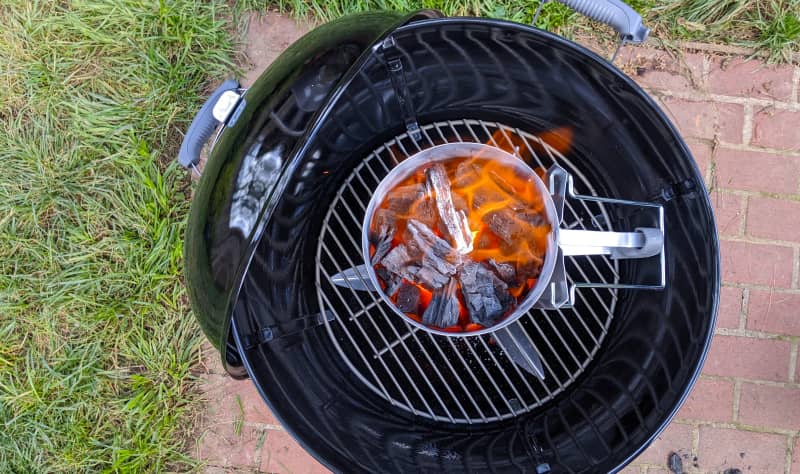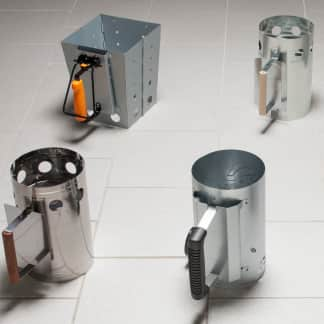Charcoal has a primal appeal. It’s one of the oldest manufactured cooking fuels, with production dating to at least the Iron Age. As ancient humans learned, charcoal is a more efficient fuel source than wood. It’s lighter, more portable, and burns more evenly.
Charcoal burns hotter than gas and produces a lot of radiant heat, which enables superior browning. Many prefer the taste of food cooked over charcoal, as the charcoal produces smoke that contributes a savory “grilled” flavor to food, making it especially delicious.


We cooked a variety of foods over each type of charcoal, including slow-cooking chuck roasts (left) and faster-cooking chicken thighs (right).
In the United States, charcoal is typically made from wood. There are two types: lump (aka hardwood) and briquettes. Both are byproducts of the lumber industry. Lump resembles the wood it comes from. Briquettes, the form of charcoal most Americans use today, are compact pucks made from sawdust and other materials.
The process for making the two is mostly the same: wood or sawdust is heated slowly at high temperatures in ovens or kilns with little or no oxygen. This drives off water, gases, and other substances, leaving behind what we cook with: char, a solid substance that is composed mostly of carbon. With briquettes, there are extra production steps. The charred sawdust is mixed with wood fiber, starches, minerals, and other ingredients and then compressed.
So, does it matter which kind of charcoal you use? To find out, we tested five of the most popular brands according to IRI, a Chicago-based market research firm, two brands of briquettes and three brands of lump. We ran heat tests and used each to cook a variety of foods. Dr. Laura Hasburgh and Dr. Kara Yedinak at the Forest Products Laboratory (FPL) of the U.S. Department of Agriculture (USDA), the national leader in scientific research on wood and wood products, helped us run additional tests and answered all of our burning questions.


What You Get in a Bag of Charcoal
To kick off our research, we turned out bags of each brand and sorted the pieces by size. The briquettes were incredibly uniform, with very few broken pieces or powder in the bags. By contrast, the lump charcoal we tested varied a lot, not only from brand to brand but also within the same bag. One brand contained mostly 4-inch cubes of wood, while another had pieces ranging from powder and pea-size chips to large 7-inch slabs. Size matters: Charcoal smaller than about an inch and a half can fall through your chimney starter or grill grates, rendering those pieces unusable. About 20 to 50 percent of the lump charcoal in the bags we surveyed was too small to use (or contained unusable foreign objects such as rocks).
Which Burns Hotter? Which Burns Longer?
Some lump charcoal enthusiasts claim that lump burns hotter than briquettes do. There turns out to be some science that supports that argument. When FPL researchers used a specialized tool called a bomb calorimeter to run controlled tests on both types of charcoal, they found that, in isolation, the lump charcoal did burn hotter. They had “greater heats of combustion”—essentially, more potential energy per gram—than the briquettes did.
Surprisingly, during our own testing we found the opposite to be true—briquettes usually produced hotter fires. When we used thermocouples to monitor the heat output of every type of charcoal, a full chimney’s worth of briquettes produced average temperature highs of 666 to 729 degrees Fahrenheit, compared with about 546 to 664 degrees for the same volume of lump.

Why the contradiction? The key has to do with how we use charcoal in the real world, outside of a controlled lab environment. Typically, we use a chimney starter to hold any kind of charcoal, as it’s the easiest way to ensure that all the charcoal ignites. This means we’re using the same volume of charcoal every time we cook—there are about 6 quarts in a full chimney—but different weights depending on the type of charcoal. As FPL researchers explained, one of the biggest reasons briquettes gave us hotter fires is because we use more of them than we do lump: A chimney starter full of briquettes weighs between 5 and 6 pounds, whereas a chimney full of lump charcoal weighs only 2 to 4.
Can Flavored Briquettes Spice Up Your Cookout?
Kingsford, the most popular charcoal briquette manufacturer, now makes flavored charcoal briquettes. Do they add anything to your food?That said, it’s hard to make any universal rules about whether lump or briquettes burn hotter overall. As Yedinak and Hasburgh explained, the heat of any fire depends on a large range of factors, including the mass, density, composition, and size of the charcoal; the way it’s arranged (and the resulting air flow); the weather; and how the charcoal was made. One thing was clear, though: A chimney full of briquettes burns longer than a chimney of lump. In our tests, full chimneys of briquettes gave us about 2.5 to 3.5 hours of cooking time (defined as temperatures above 300 degrees), compared with about 40 minutes to 2 hours for the same volume of lump.

Does Lump Charcoal Make Food Taste Better?
Another claim we’d heard was that lump charcoal makes food more flavorful—more intensely smoky or woodsy—than briquettes do. Curious to see if this were true, we cooked different foods over every brand of briquette and lump in our lineup, and for different lengths of time, grilling steak quickly and chicken thighs for about 40 minutes, and slow-roasting chuck-eye roasts for 2½ hours. We then conducted a series of blind taste tests of the food cooked on different types of lump, the food cooked on different briquettes, and the food cooked on lump versus the food cooked on briquettes.

The results surprised us: Tasters couldn’t reliably distinguish between food cooked on one kind of charcoal and food cooked on another. Everything we made was delicious, mildly smoky, and more than acceptable.

Why weren’t there significant differences? A little science is helpful here. Char, the main ingredient in both types of charcoal, is rarely (if ever) pure carbon; some wood components always remain. You might think that these different wood components would contribute different flavors to food. But in fact, this isn’t so. As FPL researchers explained, the process of making both kinds of charcoal removes the volatile flavor compounds of the raw wood. Charcoal in any form still contributes aromatic smoke—this is one of the reasons charcoal-grilled food tastes so good—but it lacks the more complex array of flavor molecules you might get from burning raw wood.
Still, from a cook’s perspective, our results should actually be reassuring. It means you can’t go wrong: Lump and briquettes can both produce equally tasty results.
Lighter Cubes Make Charcoal Grilling Easy
Lighting charcoal can be daunting. These simple cubes make it a breeze.Which Charcoal Should You Buy?
Since both types produce great-tasting food, the choice depends on your priorities and budget. Briquettes are universally accessible and inexpensive, running about 62 to 79 cents per pound. They burn hot for a long time, making them an excellent choice for everything from grilling burgers to making low-and-slow barbecue.
Lump charcoal is more expensive, costing about $1.00 to $1.87 per pound, a price difference that can be especially significant when you factor in the amount of unusable material in each bag. Because a full chimney of lump will burn faster than a full chimney of briquettes, you may need to use more of it or replenish it more frequently.

Some people think lump charcoal is better for your health than briquettes are, but there hasn’t been enough research to know one way or another (see “Is Lump Charcoal Healthier for You than Briquettes?”). Cleanup can be a little easier, though—lump produces a smaller volume of ash per chimney than briquettes do. And there’s a bit more romance to cooking over lump; because it looks like wood, it makes us feel like we’re still cooking over an ancient campfire.
No matter what you choose, it’s important to get to know your charcoal. Each brand performs differently, but if you use one kind consistently, you’ll develop a sense for how hot it gets and how long it will burn. Everything we learned about the products we tested is below. The products are unranked; we’ve listed them in order of least to most expensive, an order that also separates them into briquette and lump charcoal categories. Read on to learn which style and brand is right for you.
The Tests
- Sort the pieces in one bag of each brand of charcoal by size
- Measure heat from 6 quarts of charcoal, fully ashed, spread evenly over grill grate
- Measure heat from 7 quarts of charcoal, partially ashed, mounded on one side of grill grate
- Grill chicken thighs and evaluate differences in three stages [briquette brands against each other, lump charcoal brands against each other, One briquette brand versus two lump charcoal brands, selected at random (since no preferences were established during the lump charcoal test)]
- Grill flank steak and evaluate differences in three stages (briquette brands against each other, lump charcoal brands against each other, one briquette brand versus two lump charcoal brands)
- Make Barbecued Chuck Roast on lump charcoal and briquettes; compare flavor
- Measure the heat of combustion of each brand of charcoal using a bomb calorimeter (with the assistance of Forest Products Laboratory)
- Measure the heat release rate and mass loss of each brand of charcoal using a cone calorimeter (with the assistance of Forest Products Laboratory)
Disclaimer: The use of trade or firm names in this publication is for reader information and does not imply endorsement by the U.S. Department of Agriculture of any product or service.

















